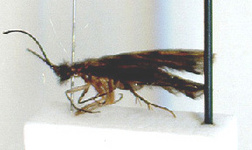Tasmiidae
Ralph W. Holzenthal, Roger J. Blahnik, Aysha Prather, and Karl Kjer


This tree diagram shows the relationships between several groups of organisms.
The root of the current tree connects the organisms featured in this tree to their containing group and the rest of the Tree of Life. The basal branching point in the tree represents the ancestor of the other groups in the tree. This ancestor diversified over time into several descendent subgroups, which are represented as internal nodes and terminal taxa to the right.

You can click on the root to travel down the Tree of Life all the way to the root of all Life, and you can click on the names of descendent subgroups to travel up the Tree of Life all the way to individual species.
For more information on ToL tree formatting, please see Interpreting the Tree or Classification. To learn more about phylogenetic trees, please visit our Phylogenetic Biology pages.
close boxIntroduction
This small family contains only 4 genera, 2 in southern Chile and 2 in southeast Australia and Tasmania, for a total of 9 species. The Chilean fauna is composed of 2 species, each in a monotypic genus, Charadropsyche penicillata Flint and Trichovespula macrocera Schmid. Tasimia Mosely contains 5 species from southeastern Australia and Tasmania, while Tasiagma Neboiss has 1 species in Australia and Tasmania and 1 on Lord Howe Island, lying between Australia and New Zealand. The family was established by Riek (1968) for the genus Tasimia, originally described in the Sericostomatidae; Trichovespula was first included in Lepidostomatidae, and later transferred to Tasimiidae by Flint (1969). Larvae all seem to build narrow to broad, flattened, tubular cases of sand grains with anterior and lateral flanges of larger mineral fragments (Flint 1967, 1999). They live in small, shallow streams where they cling to the faces of rocks. They probably feed on periphyton and organic sediments growing or adhering to the rock surfaces. (From Holzenthal et al., 2007)References
Flint, O.S., Jr. (1967) Trichoptera collected by Prof. J. Illies in the Chilean subregion. Beiträge zur Neotropischen Fauna, 5, 45–68.
Flint, O.S., Jr. (1969) Studies of Neotropical caddis flies, IX: new genera and species from the Chilean subregion. Proceedings of the Entomological Society of Washington, 71, 497–514.
Flint, O.S., Jr. (1999) The Chilean genus Charadropsyche, with the description of its immature stages (Trichoptera: Tasimiidae) (Studies of neotropical caddisflies, LVII). In: Malicky, H. & Chantaramongkol, P. (Eds.) Proceedings of the 9th International Symposium on Trichoptera. Faculty of Science, Chiang Mai University, Chiang Mai, Thailand, pp. 99–105.
Holzenthal R.W., Blahnik, R.J., Prather, A.L., and Kjer K.M. 2007. Order Trichoptera Kirby 1813 (Insecta), Caddisflies. In: Zhang, Z.-Q., and Shear, W.A. (Eds). 2007 Linneaus Tercentenary: Progress in Invertebrate Taxonomy. Zootaxa. 1668:639–698.
Riek, E.F. (1968) A new family of caddis-flies from Australia (Trichoptera: Tasimiidae). Journal of the Australian Entomological Society, 7, 109–114.
Title Illustrations

| Scientific Name | Trichovespula macrocera |
|---|---|
| Location | Chile |
| Specimen Condition | Dead Specimen |
| Life Cycle Stage | Adult |
| View | Lateral |
| Collection | UMSP |
| Source Collection | Barcode of Life Database (BOLD) |
About This Page
Ralph W. Holzenthal

University of Minnesota, St. Paul, Minnesota, USA
Roger J. Blahnik

University of Minnesota, St. Paul, Minnesota, USA
Aysha Prather

Centre for Biodiversity and Conservation Biology, Royal Ontario Museum, Toronto, Ontario, Canada
Karl Kjer

Rutgers University, New Brunswick, New Jersey, USA
Correspondence regarding this page should be directed to Ralph W. Holzenthal at , Roger J. Blahnik at , Aysha Prather at , and Karl Kjer at
Page copyright © 2010 Ralph W. Holzenthal, Roger J. Blahnik, Aysha Prather, and Karl Kjer
 Page: Tree of Life
Tasmiidae.
Authored by
Ralph W. Holzenthal, Roger J. Blahnik, Aysha Prather, and Karl Kjer.
The TEXT of this page is licensed under the
Creative Commons Attribution-NonCommercial-ShareAlike License - Version 3.0. Note that images and other media
featured on this page are each governed by their own license, and they may or may not be available
for reuse. Click on an image or a media link to access the media data window, which provides the
relevant licensing information. For the general terms and conditions of ToL material reuse and
redistribution, please see the Tree of Life Copyright
Policies.
Page: Tree of Life
Tasmiidae.
Authored by
Ralph W. Holzenthal, Roger J. Blahnik, Aysha Prather, and Karl Kjer.
The TEXT of this page is licensed under the
Creative Commons Attribution-NonCommercial-ShareAlike License - Version 3.0. Note that images and other media
featured on this page are each governed by their own license, and they may or may not be available
for reuse. Click on an image or a media link to access the media data window, which provides the
relevant licensing information. For the general terms and conditions of ToL material reuse and
redistribution, please see the Tree of Life Copyright
Policies.
- First online 17 July 2010
- Content changed 20 July 2010
Citing this page:
Holzenthal, Ralph W., Roger J. Blahnik, Aysha Prather, and Karl Kjer. 2010. Tasmiidae. Version 20 July 2010 (under construction). http://tolweb.org/Tasmiidae/14577/2010.07.20 in The Tree of Life Web Project, http://tolweb.org/







 Go to quick links
Go to quick search
Go to navigation for this section of the ToL site
Go to detailed links for the ToL site
Go to quick links
Go to quick search
Go to navigation for this section of the ToL site
Go to detailed links for the ToL site